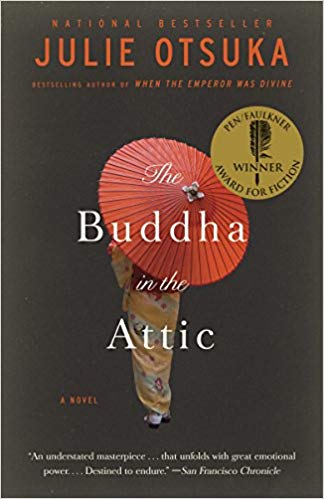
The 2011 book The Buddha in the Attic by Julie Otsuka tells the story of Japanese picture brides in the early twentieth century. The story follows their journey starting from coming to the United States to being sent to internment camps in WWII. Japanese picture brides were a group of women that immigrated to the United States from Japan. In the early twentieth century Japanese workers could send a picture (although not always a truthful photograph) to Japan where a matchmaker would set up a marriage. These young girls often immigrated after only seeing a snapshot of their future husband. The bride and groom would marry on the docks, and then start their new life together in the United States. The young girls often had very little idea of what would happen in their new life. As seen in Otsuka’s book, the experiences could be harrowing.
Written in the first-person plural, the book follows a group of women who sail over to the United States together. The story centers around their collective experience. Short asides with different women’s names and individual events explain the differences in each girl’s life. This writing style is very powerful. Almost poetic in nature, the reader can feel the emotions of a whole group. Yet, the reader does not lose the fact that each individual had a very different experience. The book follows the girls’ lives from their arrival, to having their own children, and finally to the aftermath of the attack on Pearl Harbor. Otsuka shares the experiences of the girls and the people around them. Although the book is short, its impact on me has been lasting.
A fan of historical fiction, I was tired of reading what felt like the same plot line in different settings. When I picked up The Buddha in the Attic, I finally found a book that was different than any other book I had read in the genre. The collective nature of the story portrays a historical movement instead of a singular experience. While so many stories are given, it is not difficult to follow along. The emotion of these girls’ experiences stands out more than a detail of one person’s life. This book shows the strength of young girls as they embark on a new life. They must overcome racism, abuse, poverty, and much more in their new lives. The amazing resilience of these girls is unimaginable. It is a good book for young girls to read, painting a picture of Japanese immigrants in the twentieth century. The book focuses on a young group of girls, not only giving more information on a historical phenomenon, but showing challenge and struggles that many immigrants face, along with their bravery — even in horrifying situations.
-Rebekah Mills
Junior Girl
Girl Museum Inc.

Sounds like a great read! Well I did read it, and it was really good!